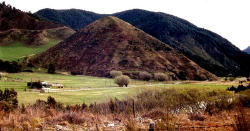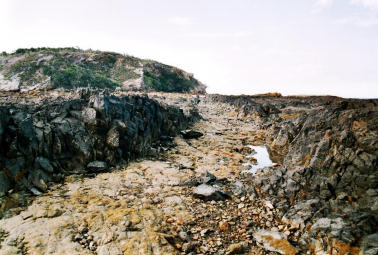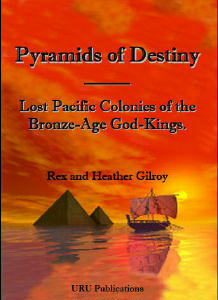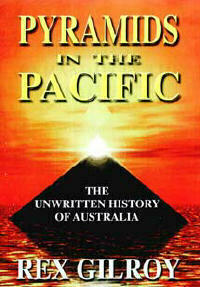
| Pyramids of Destiny – Lost Pacific Colonies of the Bronze-Age God-Kings |
 |
Extensive wide, deep channels were carved out of the southern part of the island’s base rock by the miners, following rich veins of pitchblend, as seen here.
Photo copyright © Rex Gilroy 2008.
|
Pyramids of Destiny – Lost Pacific Colonies of the Bronze-Age God-Kings
by Rex & Heather Gilroy
Copyright
© Rex Gilroy 2009
| “Australian history is almost always picturesque; indeed it is so curious and strange, that it is itself the chiefest novelty the country has to offer, and so it pushes all other novelties into second and third place. It does not read like history but like the most beautiful lies. Mark Twain: Following the Equator [1891] |
”Every truth passes through three stages before it is recognised. In the first, it is ridiculed. In the second, it is opposed. In the third, it is regarded as self evident.” Arthur Schopenhauer [1788-1860] |
Part Three.
Lost Egypto-Phoenician Colonies of Queensland’s Far North.
Chapter Seventeen.
Baal Worshippers of Ancient Mackay.It was August 2003 and we were driving north once again bound for a resumption of our Sarina investigations.
During the year we had been away, the amateur geologists who had started all the media publicity about the ancient stone wharf in Sarina Inlet, had uncovered further ‘ancient’ slag heaps in areas where there had been some 19th and early 20th century mining operations, including an ‘ancient’ quarry, which they were eager to show us.
We like to encourage amateur research in archaeological matters and visiting their sites gave me the opportunity to advise them on ways of telling the difference between ancient and more recent mining operations. One of their ‘ancient’ slag deposits covering some acres of scrub-covered land looked impressive at first glance. It was covered by about 40cm or so of soil from past floods, the stratification easily viewed by walking along a deep, eroded occasional creek bed.
As the area was pretty rough-looking Heather stayed at the car, parked on a lonely bush track. Besides as the snakes were beginning to appear in these hotter northern climes I decided that it was better for me to take such risks in this thick grassy scrub. Snake trails were visible on the tracks as the men showed me about the area, then conducted me along the dry creek bed, pointing out the ‘ancient’ mining slag, from which at one point I extracted a sizeable fragment of a 1920s beer bottle. “Good things come in glass” says a famous commercial jingle; however the Egyptians and Phoenicians drank their beer from earthen jugs!
The enthusiastic group then showed me the ‘ancient’ quarry, from whose rubble further examples of broken glass and other old ‘junk’ was later collected by me. I later learnt from other locals that the ‘ancient’ quarry was the work of an early Sarina City Council rather than ancient colonists.
The boys had spent the intervening months since our previous visit organising an “archaeological conference” at which I was to be the principal guest speaker. We had brought along our slide projector, dozens of lecture slides, as well as a display of ancient rock inscriptions and other relics for the occasion, and I had spent months perfecting my lecture notes.
Finally, when the big day came the venue for the conference, the City Hall, soon filled with an assortment of curious locals, an alderman, a local politician, as well as some genuinely interested students of history, one of whom had flown all the way from Adelaide to Sarina to hear my talk.
The geology group had put on a display of - you guessed it - mining slag, as well as dubious ‘ancient’ relics from the Sarina stone wharf and elsewhere and there was a fine collection of local sea life. However, it was the Gilroys’ display of fossil hominid [pre-Aboriginal] skull-types, stone ‘megatools’, rock inscriptions and other pre-Cook relics of our ‘unwritten’ history which attracted the most attention from the visitors, which displeased the organisers no end!
There had been a cancellation or two of pre-arranged guest speakers, so to fill in, an elderly gentleman from the group gave a tired, overlong talk on Captain Cook’s “voyage of discovery” along our east coast, while another member of the group spoke on the ‘ancient’ mining sites of Sarina which they had discovered.
Then came my presentation and the revelations of ancient mining colonies established Australia-wide during the Bronze-Age, and of the mass of ancient colony evidence so far unearthed by Heather and I in Queensland. After a tea break, the local politician gave a ‘lecture’ on totally unrelated political matters, and it was obvious that he had been invited along just to beg votes for himself at the next election!
My presentation slides had included real relics of ancient Middle-East origin recovered at undoubted ancient mining sites in the Sarina district and elsewhere in Queensland, all of which tended to dismiss the ‘evidence’ of these amateur geologists, who took an immediate dislike to us.
Yet is it not better to present a more convincing case with factual relics, than a lot of hearsay material in order to prove a theory? Mineral ores gathered from the ancient stone wharf and out in the bush prove nothing, any more than old-looking open-cut excavations in hillsides are proof of ancient mining operations; unless of course the site reveals ancient pottery, rock inscriptions or similar evidence.
Heather and I have uncovered a great deal of inscriptions and other convincing relics, pointing to ancient civilisation contacts with Australia, in the course of our many years of field research. That our successes have attracted a great deal of jealousy from certain quarters is regrettable, considering that our researches and all the discoveries we are making are for the benefit of future generations of Australians.
For by our endeavours we have expanded the hitherto confining “politically correct” boundaries of this continent’s history, so that future researchers will no longer regard Australia as a mere historical ‘backwater’, but rather the forefront of World History!
Following the conference we carried out another investigation of the ancient stone wharf at Freshwater Point on Sarina Inlet. As the tide was out rubble close to the shoreline was exposed. As we searched about I spotted a faded rock inscription. A close inspection revealed the script to be Libyan. Nearby I picked up a roundish, grey coloured inscribed stone, Libyan script once again, and soon afterwards two small stones bearing human face carvings both front and back.Later study of the roundish grey stone showed it was engraved upon three sides. On one side was the message: “Bel above all”. The second side stated “Temple of Bel”, and the third: “This stone declares, on this land stands the Temple of Bel, who is above all”.
This stone measuring 12cm tall by 16.5cm width and 9cm thick, was a Message stone”, formerly placed at the entrance of a shrine or temple to Bel [the Celtic Sun-God], which formerly stood near the entrance to the wharf. These latest finds probably date to around 1600BC and are further evidence of a Celtic presence in this colony.
However, towards the eastern [ocean front] end of the wharf, we stumbled upon an even larger relic, an altar stone which we measured at 53cm length by 45cm width and 18cm tall. It bore Phoenician letterings which formed the message:“The altar of Ra,
placed for the God of the workers,
for whom it is inscribed”.Yet an even larger relic stands some distance beyond the Sarina town limits deep in farmland. Rising up out of the tall seagrass and surrounded by a vast sugarcane farm, on our previous Sarina inspections Heather and I had observed a four-sided pyramid hill at least 45m in height. Trees and undergrowth now cover the formation, which gives every sign of having been deliberately shaped by human hands in the dim past.
The pyramid hill was surely shaped from a more rounded natural formation for ceremonial and astronomical purposes. It is not the only one of its kind in the district. We know of others that we have located, but prefer to keep their locations secret, and besides, like this one, they all stand on private property, which protects them from all but trespassers…
Main Book Index | Mysterious Australia Homepage | URU Homepage | Australian Yowie Research Centre

